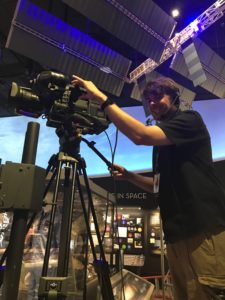Paul Morris ’10 grew up recording epic space battles on stop-action film. He’d pose and re-pose Star Wars figures, capturing them with a Sony Super 8 camera that kept conking out.

Now a video producer for NASA, Morris’s outer-space odysseys are a bit more high-tech. A documentary he created – from conception to final cut – for this spring’s 30th anniversary of the Hubble Space Telescope, went into orbit on social media. With a theatre degree he didn’t know existed when he got to college – and the teamwork and storytelling skills that came with it – Morris turned his innate fascination with all things galactic into a soaring career.
“It’s been an absolute dream,” he said. “I’ve always been obsessed with space and with NASA.”
UMW, too, was ingrained in Morris, whose grandparents Marceline Weatherly Morris ’50 and Elmer “Juney” Morris Jr. ’50, married seven decades this month, began their courtship at Mary Washington. Paul Morris took a cue from the couple, meeting fellow theatre major Cassie Lewis ’11 on campus and marrying her beneath a magnolia tree in his Nana’s backyard.
As his love for Cassie grew throughout college, so did his passion for theatre, and he earned parts in productions like Shakespeare’s R&J and Our Town. Behind the scenes, especially with UMW’s Studio 115 black box theatre group, he’d spill out his wildest ideas and cajole cast and crew to bring them to life.
“I always thought of him as a storyteller,” said Department of Theatre Chair Gregg Stull. “Even as a student he understood that many people have great ideas but what matters is doing the work to bring those ideas to fruition.”
Effort wasn’t an issue for Morris. When Cassie graduated a year after him, they moved to New York, landing jobs at the social publisher Little Things and producing Refresh, a Facebook Live show featuring guests like Melissa Joan Hart and Fiona Silver.


They’d climbed into senior production at parenting platform Wild Sky Media when Morris set his sights on a job at NASA’s Goddard Space Flight Center, sharing the story of the Hubble Space Telescope. “The sheer idea of putting a telescope in space – and the fact that it works – is just wild to me,” said Morris, who was 2 when it launched.
He landed the job last spring, making videos about servicing missions and scientific discoveries, and archiving thousands of hours of footage captured by Hubble. Digitizing dusty Betamax tapes and embedding MP4s with metadata was tedious, he said, but exciting. “I’ll have in my hands a videotape filmed in space, and I’m the first person on Earth to watch it, sometimes … ever.”

With Hubble’s 30th anniversary hovering, an idea emerged. Morris began stitching decades of B-Roll, photos and clips together with his own original interviews with astronauts and astronomers who’ve supported Hubble’s mission and kept it in flight. The result, NASA’s Incredible Discovery Machine: The Story of the Hubble Space Telescope, is a 50-plus-minute account of the trials and tribulations in the life of this amazing machine.
“There were moments when I was editing when I was near tears,” said Morris, whose time at Mary Washington reinforced the value he places on hard work.
He spent many on-the-clock – and personal – hours compiling the documentary, determined to forego text and voice-over options in favor of bona-fide footage and dialogue. With more than 400,000 views on social media so far, the film casts its producer’s awe for space exploration into the universe.
“Hubble shows us how small we are … ” said Morris, who, on some star-speckled nights, peers into the sky with his own telescope. “We’re lucky to know how small we are because it shows how much bigger we can be.”




